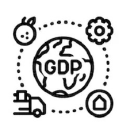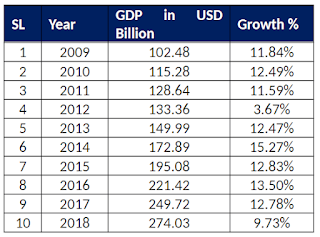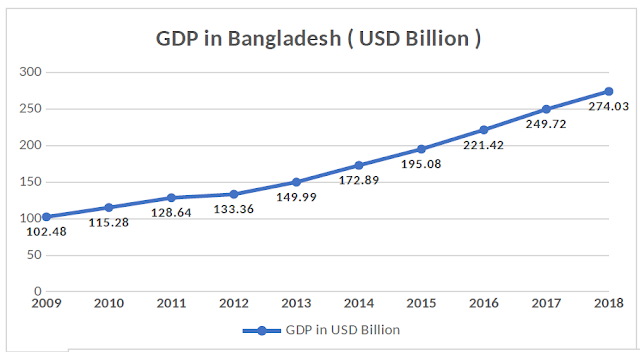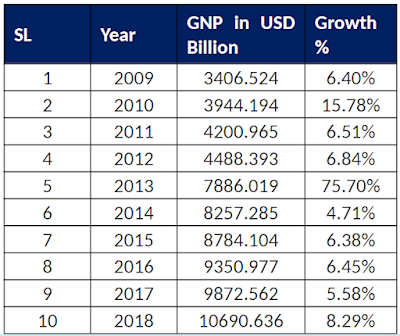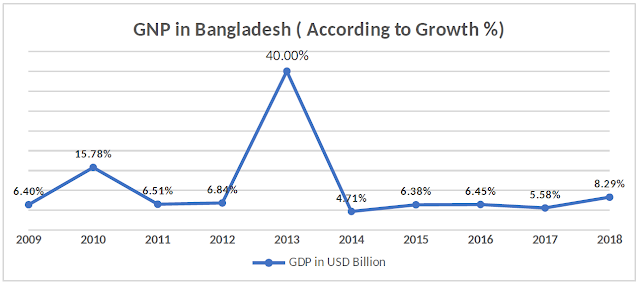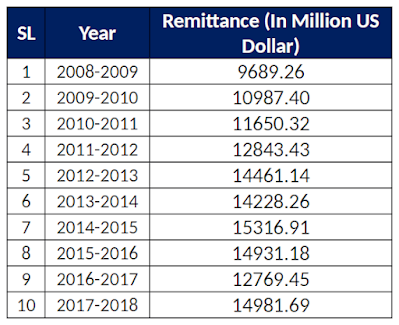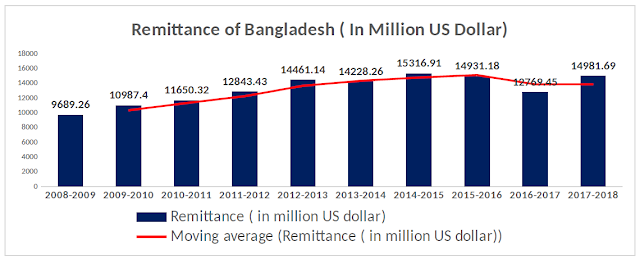The market-based economy of Bangladesh is one of the fastest growing economies in the world. It's the 41st largest in the world in nominal terms, and 30th largest by purchasing power parity; it is classified among the Next Eleven emerging market middle income economies and a Frontier market. According to the IMF, Bangladesh's economy is the second fastest growing major economy of 2016, with a rate of 7.1%. Dhaka and Chittagong are the principal financial centers of the country, being home to the Dhaka Stock Exchange and the Chittagong Stock Exchange. The financial sector of Bangladesh is the second largest in the subcontinent.
In the decade since 2004, Bangladesh averaged a GDP growth of 6.5%, that has been largely driven by its exports of readymade garments, remittances and the domestic agricultural sector. The country has pursued export-oriented industrialization, with its key export sectors include textiles, shipbuilding, fish and seafood, jute and leather goods. It has also developed self-sufficient industries in pharmaceuticals, steel and food processing. Bangladesh's telecommunication industry has witnessed rapid growth over the years, receiving high investment from foreign companies. Bangladesh also has substantial reserves of natural gas and is Asia's seventh largest gas producer. Offshore exploration activities are increasing in its maritime territory in the Bay of Bengal. It also has large deposits of limestone. The government promotes the Digital Bangladesh scheme as part of its efforts to develop the country's growing information technology sector.
Bangladesh is strategically important for the economies of Northeast India, Nepal and Bhutan, as Bangladeshi seaports provide maritime access for these landlocked regions and countries. China also views Bangladesh as a potential gateway for its landlocked southwest, including Tibet, Sichuan and Yunnan.
As of 2019, Bangladesh's GDP per capita income is estimated as per IMF data at US$4,992 (PPP) and US$1,888 (nominal). Bangladesh is a member of the D-8 Organization for Economic Cooperation, the South Asian Association for Regional Cooperation, the International Monetary Fund, the World Bank, the World Trade Organization and the Asian Infrastructure Investment Bank. The economy faces challenges of infrastructure bottlenecks, insufficient power and gas supplies, bureaucratic corruption, political instability, natural calamities and a lack of skilled workers.
What Do You Mean By Economic Activity? What Are The Factors That Influence Economic Activity?Factors affecting economic activity -
1) Supply and demand
2) Interest rates
3) Inflation
4) Unemployment
5) Foreign exchange rates
6) Land, labor, capital and entrepreneurship also affects economic activity of any nation.
GDP
Gross domestic product (GDP) is a monetary measure of the market value of all the final goods and services produced in a specific time period, often annually. GDP per capita does not, however, reflect differences in the cost of living and the inflation rates of the countries; therefore, using a basis of GDP per capita at purchasing power parity (PPP) is arguably more useful when comparing differences in living standards between nations.
The Gross Domestic Product (GDP) in Bangladesh was worth 274.03 billion US dollars in 2018. The GDP value of Bangladesh represents 0.44 percent of the world economy. GDP in Bangladesh averaged 53.02 USD Billion from 1960 until 2018, reaching an all-time high of 274.03 USD Billion in 2018 and a record low of 4.27 USD Billion in 1960.
Table -1 : The Picture of last 10 (Ten) years of GDP in Bangladesh.
Bangladesh is considered as a developing economy. Yet, almost one-third of Bangladesh’s 150m people live in extreme poverty. In the last decade, the country has recorded GDP growth rates above 5 percent due to development of microcredit and garment industry. Although three fifths of Bangladeshis are employed in the agriculture sector, three quarters of exports revenues come from producing ready-made garments. The biggest obstacles to sustainable development in Bangladesh are overpopulation, poor infrastructure, corruption, political instability and a slow implementation of economic reforms. This page provides - Bangladesh GDP Growth Rate - actual values, historical data, forecast, chart, statistics, economic calendar and news. Bangladesh GDP Growth Rate - actual data, historical chart and calendar of releases - was last updated on July of 2019.
GNPGross national product (GNP) is an estimate of total value of all the final products and services turned out in a given period by the means of production owned by a country's residents. GNP is commonly calculated by taking the sum of personal consumption expenditures, private domestic investment, government expenditure, net exports and any income earned by residents from overseas investments, minus income earned within the domestic economy by foreign residents. Net exports represent the difference between what a country exports minus any imports of goods and services.
Bangladesh GNP Growth Rate
Gross National Product in Bangladesh increased to 11550.46 BDT Billion in 2019 from 10690.64 BDT Billion in 2018. Gross National Product in Bangladesh averaged 5889.35 BDT Billion from 2003 until 2019, reaching an all-time high of 11550.46 BDT Billion in 2019 and a record low of 2483.46 BDT Billion in 2003.
Inflation Inflation is a quantitative measure of the rate at which the average price level of a basket of selected goods and services in an economy increases over a period of time. It is the constant rise in the general level of prices where a unit of currency buys less than it did in prior periods. Often expressed as a percentage, inflation indicates a decrease in the purchasing power of a nation’s currency.
Remittance
Remittances in Bangladesh decreased to 1368.20 USD Million in June from 1748.16 USD Million in May of 2019. Remittances in Bangladesh averaged 1220.70 USD Million from 2012 until 2019, reaching an all-time high of 1748.16 USD Million in May of 2019 and a record low of 856.87 USD Million in September of 2017.
Remittances Source - https://tradingeconomics.com/bangladesh/remittancesGDP & GNP source- https://tradingeconomics.com/bangladesh/gdpInflation source - https://knoema.com/atlas/Bangladesh/Inflation-rate

